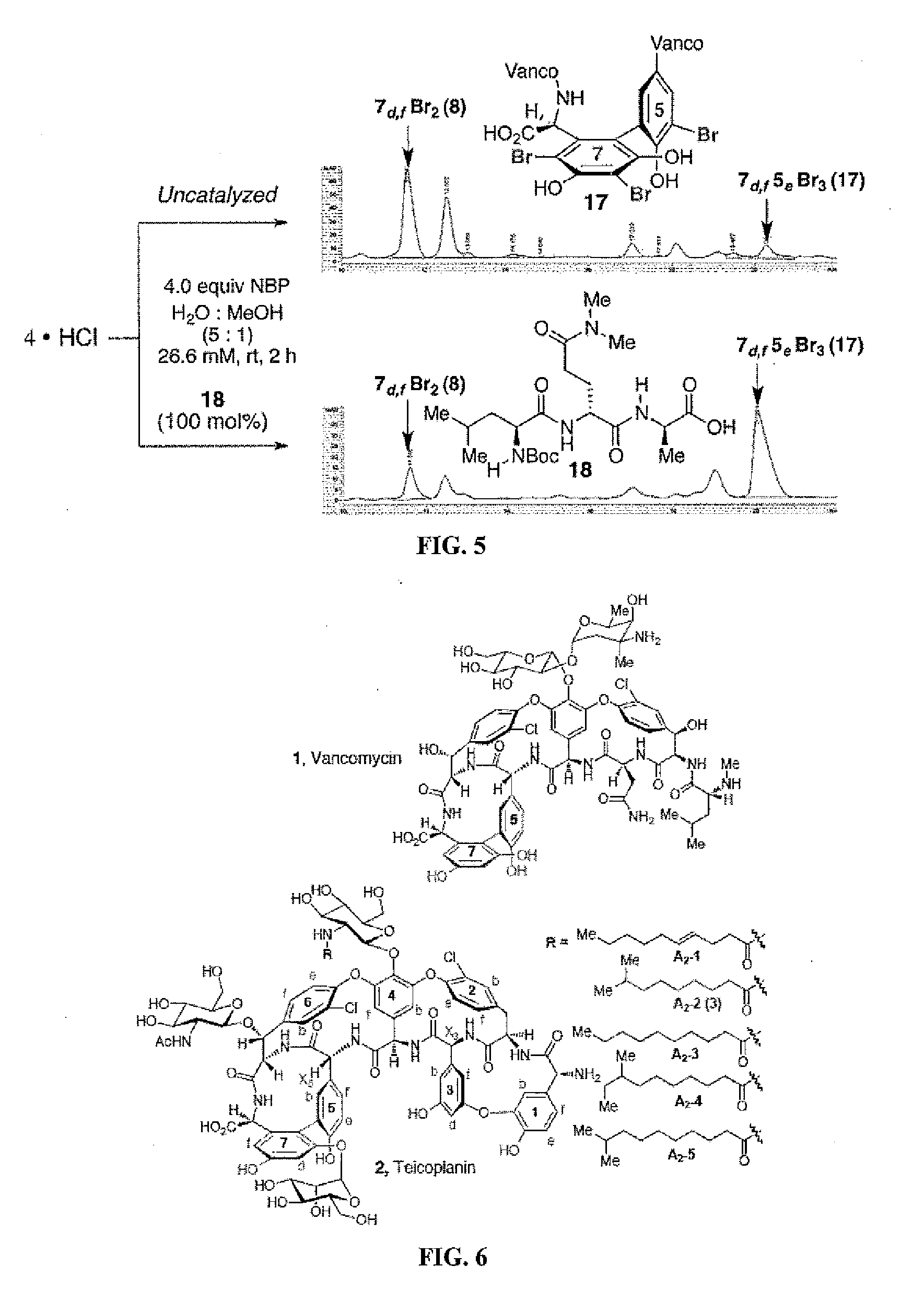Site-selective functionalization of glycopeptide antibiotics
a glycopeptide and functionalization technology, applied in the field of glycopeptide antibiotic derivatives, can solve the problem of restricted use of glycopeptide antibiotics, and achieve the effect of improving the activity against methicillin-susceptible bacteria
- Summary
- Abstract
- Description
- Claims
- Application Information
AI Technical Summary
Benefits of technology
Problems solved by technology
Method used
Image
Examples
example 1
[0234]Halogenation in Absence of Catalyst
[0235]The hydrochloride salt of vancomycin (4) was reacted with 2.0 equiv. of N-bromophthalimide (NBP) at room temperature for 12 hours in water:methanol (5:1) to form a mixture of products, of which unreacted vancomycin was a major component. Additional products included 7f-Br vancomycin (5), 6d-Br vancomycin (6), and 7d,f-Br vancomycin (8). The structures and HPLC trace are shown in FIG. 1.
[0236]Halogenation in the Presence of Peptide Catalysts
[0237]Given the well-known binding of vancomycin (4) to DAla-DAla (FIG. 2) segments of the bacterial cell wall as part of its biological mode of action, a series of peptide catalysts were designed based on this molecular recognition motif. The catalysts retained the DXaa-DXaa dipeptide motif as part of a binding domain between the catalyst and the substrate. In addition, N,N-dimethylamide functionality, which was predicted to accelerate the bromination reactions, was incorpor...
example 2
Halogenation of Teicoplanin
[0249]The structures of vancomycin and teicoplanin are shown in FIG. 6. Given the heightened biological activity and higher level of molecular complexity of teicoplanin compared to vancomycin, site-selective halogenation of teicoplanin was investigated. The structure of teicoplanin presents the additional challenge of tuning the site of bromination to either the 5,7-biaryl region of the structure (2, FIG. 6, rings 5 and 7) or the 1,3-biaryl-ether region (2, FIG. 6, rings 1 and 3). The intrinsic reactivity of these moieties, relative to one another, was not completely clear at the outset. Thus, one of the key goals of the study was to evaluate catalysts / conditions that could provide site-selective bromination of either biaryl ring system. Teicoplanin was purified to isolate teicoplanin A2-2 (3, FIG. 6) from the readily available mixture of teicoplanins, which is a composite of approximately six to nine molecular forms of teicoplanin.
[0250]Halogenation in th...
PUM
| Property | Measurement | Unit |
|---|---|---|
| melting point | aaaaa | aaaaa |
| pH | aaaaa | aaaaa |
| pH | aaaaa | aaaaa |
Abstract
Description
Claims
Application Information
 Login to View More
Login to View More - R&D
- Intellectual Property
- Life Sciences
- Materials
- Tech Scout
- Unparalleled Data Quality
- Higher Quality Content
- 60% Fewer Hallucinations
Browse by: Latest US Patents, China's latest patents, Technical Efficacy Thesaurus, Application Domain, Technology Topic, Popular Technical Reports.
© 2025 PatSnap. All rights reserved.Legal|Privacy policy|Modern Slavery Act Transparency Statement|Sitemap|About US| Contact US: help@patsnap.com



